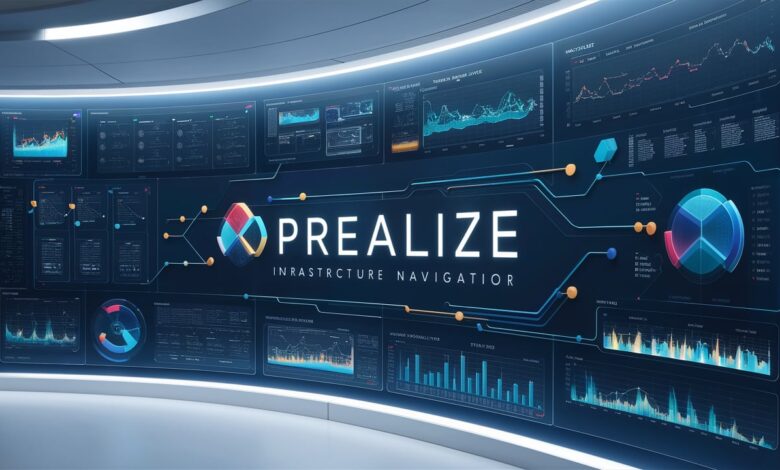VRealize Infrastructure Navigator: A Complete Guide to Application Mapping and Dependency Visualization

In the rapidly evolving world of IT infrastructure, visibility and control are key elements that determine the success of any enterprise data center. VRealize Infrastructure Navigator , developed by VMware, stands as one of the most powerful tools for application dependency mapping and infrastructure visualization. It helps IT administrators and cloud architects identify, monitor, and manage application relationships across complex virtualized environments.
By offering real-time insights into how applications interact with each other and with the underlying infrastructure, VRealize Infrastructure Navigator allows businesses to enhance operational efficiency, optimize resource allocation, and ensure application uptime. This article provides a comprehensive exploration of what VRealize Infrastructure Navigator is, how it works, and why it remains an essential component of modern data center management.
What Is VRealize Infrastructure Navigator?
VRealize Infrastructure Navigator is an application discovery and dependency mapping solution integrated within the VMware vRealize Suite. It automatically identifies applications running inside virtual machines and maps the dependencies between those applications and the underlying infrastructure components, such as servers, storage systems, and network layers.
This powerful visualization enables IT teams to understand which services depend on others, how workloads are distributed, and what impact a system failure or maintenance window might have on business operations. In simpler terms, vRIN acts as a digital map of your virtual ecosystem, revealing hidden interconnections that can be critical during troubleshooting, upgrades, or migrations.
Key Features of VRealize Infrastructure Navigator
The strength of VRealize Infrastructure Navigator lies in its feature-rich environment, designed to simplify IT operations and enhance business continuity. Below are its core capabilities explained in detail:
1. Automatic Application Discovery
One of vRIN’s most powerful features is its automated application discovery mechanism. It detects applications running on virtual machines without requiring manual intervention. This feature eliminates the tedious process of manually documenting and updating application relationships, saving significant time and effort for administrators.
2. Application Dependency Mapping
VRealize Infrastructure Navigator automatically maps application-to-application and application-to-infrastructure dependencies, helping teams visualize how different services interact within the environment. This insight is crucial for impact analysis, change management, and disaster recovery planning.
3. Real-Time Infrastructure Visibility
With vRIN, administrators gain real-time visibility into infrastructure components supporting key business applications. This enables proactive monitoring and quick decision-making in the event of performance degradation or hardware failure.
4. Integration with vCenter Server
Because VRealize Infrastructure Navigator integrates directly with VMware vCenter Server, it provides a seamless management experience. Users can view dependency maps and application details directly from the vSphere Web Client, ensuring smooth workflow continuity.
5. Enhanced Change Management and Risk Mitigation
By understanding how changes to one system affect others, organizations can minimize risk during upgrades, patching, or configuration changes. The dependency insights provided by vRIN reduce downtime and ensure service reliability across the entire IT landscape.
How VRealize Infrastructure Navigator Works
The operation of VRealize Infrastructure Navigator is based on a combination of agentless data collection, pattern recognition, and metadata analysis. Here’s a breakdown of how it functions:
-
Discovery Phase:
vRIN automatically scans virtual machines managed by vCenter and detects installed applications using network communication patterns, system processes, and port-level data. -
Mapping Phase:
Once discovered, vRIN creates interactive maps showing relationships between applications, middleware, databases, and supporting infrastructure components. These visual maps allow administrators to see exactly how systems interact in real time. -
Visualization Phase:
Through the vSphere Web Client, users can access detailed dependency graphs that display how virtual machines and applications depend on one another. This information is critical for troubleshooting, maintenance planning, and workload migration. -
Ongoing Monitoring:
vRIN continuously updates its maps as changes occur in the environment. Whether a new VM is deployed or an application is modified, vRIN ensures that the visualization remains accurate and up-to-date.
Benefits of Using VRealize Infrastructure Navigator
The adoption of VRealize Infrastructure Navigator brings a wide range of business and technical advantages. Some of the most notable include:
1. Improved Operational Efficiency
With automated discovery and visualization, administrators spend less time documenting dependencies and more time focusing on strategic improvements and optimization.
2. Better Decision Making
By providing an accurate view of application relationships, vRIN empowers IT leaders to make data-driven decisions during resource allocation, scaling, and change management.
3. Reduced Downtime
Understanding how systems interconnect helps prevent unintentional disruptions during maintenance or upgrades. This translates into higher availability and reliability for mission-critical services.
4. Simplified Compliance and Auditing
vRIN helps organizations maintain compliance by providing detailed insight into application infrastructure relationships, which can be vital during security audits or IT governance checks.
5. Enhanced Cloud Migration Planning
When migrating workloads to hybrid or multi-cloud environments, vRIN’s dependency maps allow teams to identify which components must move together, ensuring seamless and error-free transitions.
Use Cases of VRealize Infrastructure Navigator
The real-world applications of VRealize Infrastructure Navigator span across multiple domains. Here are some of its most common use cases:
1. Application Discovery During Data Center Consolidation
When consolidating data centers, vRIN helps identify all running applications and their dependencies, ensuring that nothing critical is lost during the migration process.
2. Disaster Recovery Planning
vRIN allows IT teams to visualize critical service dependencies, making it easier to design robust disaster recovery strategies and identify single points of failure.
3. Performance Optimization
By revealing how applications communicate, administrators can fine-tune resource allocations to improve overall system performance.
4. IT Compliance and Security
Knowing every connection between systems helps detect unauthorized applications or unusual traffic patterns, contributing to stronger security posture.
VRealize Infrastructure Navigator and Digital Transformation
In the era of digital transformation, organizations are increasingly embracing cloud computing, automation, and containerization. Tools like VRealize Infrastructure Navigator play a pivotal role in ensuring that these transitions are smooth and efficient.
By mapping legacy applications and understanding their infrastructure dependencies, vRIN helps enterprises plan modernization efforts with precision. Whether moving to VMware Cloud on AWS or implementing microservices architectures, vRIN acts as a guide, ensuring no critical link is broken during transformation.
Alternatives and Successors to VRealize Infrastructure Navigator
While VMware discontinued VRealize Infrastructure Navigator as a standalone product, its core capabilities have been integrated into other VMware Cloud Management solutions, such as vRealize Operations (vROps) and vRealize Network Insight (vRNI).
These tools expand upon vRIN’s original functionality, offering deeper insights into network flows, performance analytics, and security posture. As such, users transitioning from vRIN can continue benefiting from advanced dependency mapping and infrastructure intelligence within the broader VMware ecosystem.
Conclusion: Why VRealize Infrastructure Navigator Still Matters
Although technology evolves rapidly, the principles behind VRealize Infrastructure Navigator remain highly relevant. Understanding how applications and infrastructure components interact is essential for efficient IT management, risk mitigation, and digital innovation.
Whether you’re modernizing legacy systems, managing a virtual data center, or migrating to the cloud, the foundational capabilities pioneered by vRIN continue to empower IT professionals to see the unseen—to visualize, optimize, and secure their digital environments effectively.
In the ever-complex world of virtualization, VRealize Infrastructure Navigator remains a reminder that visibility is the first step toward mastery.
Frequently Asked Questions (FAQ)
1. What is VMware VRealize Infrastructure Navigator used for?
It’s used for discovering applications running on virtual machines and mapping their dependencies to help administrators manage and optimize their infrastructure.
2. Does VRealize Infrastructure Navigator still exist?
While vRIN as a standalone product is discontinued, its features have been integrated into vRealize Operations and vRealize Network Insight.
3. How does vRIN help in cloud migration?
It identifies dependent applications and systems that must move together, ensuring smooth transitions without data loss or service interruption.
4. Is VRealize Infrastructure Navigator agent-based or agentless?
It is agentless, meaning it gathers information without installing additional software inside virtual machines.
5. What are the benefits of application dependency mapping?
It provides visibility, reduces downtime, improves decision-making, and supports compliance by showing how applications and systems are interlinked.



